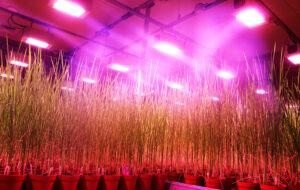by Debabrata Nath, Panneerselvam Peramaiyan, and Virender Kumar
Periodically assessing the soil’s health is very important to show the effect of current agricultural practices on the soil and maintain soil nutrients at optimum levels using new management practices. Mid-infrared (MIR) spectroscopy provides an alternative highly effective method for rapidly and cost-effectively estimating soil properties.

Precision fertilizer management at scale requires a thorough understanding of the spatial variability of soil characteristics. The rapid analysis of large numbers of soil samples within a short span of time is necessary for fertilizer recommendation. However, conventional methods of soil analysis (wet chemistry) are expensive, laborious, time-consuming, and rely on hazardous chemicals.
Mid-infrared (MIR) spectroscopy provides an alternative highly effective method for rapidly and cost-effectively estimating soil properties. MIR spectroscopy is a dry-chemistry-based soil analysis that does not use chemical reagents. Instead, it measures the amount of light reflected by a soil sample in the mid-infrared spectral regions as it reacts to its organic and inorganic composition.
Soil moisture, organic matter, carbonates, minerals, and texture are the main constituents influencing the shape of soil reflectance in the MIR region. Additionally, a single spectrum is sufficient for determining the properties of various soils.
The Soil Health Card
Periodically assessing the soil’s health is very important to show the effect of current agricultural practices on the soil and maintain soil nutrients at optimum levels using new management practices. With this goal in mind, the Ministry of Agriculture and Farmers’ Welfare, India, initiated the Soil Health Card (SHC) scheme in 2015 to provide field-specific nutrient recommendations.
By receiving the SHC every three years, farmers will be able to apply recommended doses of nutrients based on soil test values to improve soil health, reduce the cost of cultivation, and increase profits.
Conventional laboratory standard procedures are followed for the processing of soil samples and analysis of the following parameters:
- pH
- electrical conductivity
- soil organic carbon
- nitrogen
- phosphorus
- potassium
- sulfur
- boron
- zinc
- iron
- manganese
- copper
The soil samples are collected twice a year by the State Government’s Department of Agriculture or an outsourced agency after harvesting when there is no standing crop in the field.
In the wet chemistry analysis, soil samples are mixed with an extractant solution which destroys the samples and prevents further analysis of it. In addition, the conventional lab analysis results tend to fluctuate due to differences in standards and methodologies adopted by laboratories across the country. Because soil samples can only be used once, conventional methods are overwhelmed by the large volume of soil samples collected within a short period of time, which may affect the generation of high-quality data.
Soil sample analysis using MIR spectroscopy
MIR spectroscopy is both fast and cost-effective. It only takes 30 seconds to test samples and is 10 times cheaper than conventional lab analysis. This method is environment-friendly, non-destructive, and reproducible. It reduces the need for wet chemistry-based soil analysis and is a repeatable analytical technique. Light reflectance, being a physical measurement, can provide greater consistency across laboratories compared with chemical reference methods.
It is recommended that soil samples should be air-dry and passed through a 2 mm sieve. Subsamples can be taken using the coning and quartering method and ground to a fine powder size between 20 and 53 microns using the RM 200 Restch motor grinder,
Fill the aluminium sample cup with finely ground soil to load the soil sample. It takes approximately one to two grams, depending on the type of soil. Remove any excess soil with a straight-edged tool, such as a glass slide. In the sample holder, place the loaded samples followed by making a data sheet that indicates the identification of the respective sample.
Most common applications of MIR Spectroscopy
Prediction of soil’s chemical properties: Using MIR spectroscopy, it was possible to accurately predict soil pH, soil organic carbon, calcium carbonate, and available N content in the soil. Numerous studies reported correlation coefficients (R2) ranging from 0.8 to 0.9. between the actual and predicted values.
Prediction of soil’s physical properties: MIR spectroscopy is capable of determining soil physical properties such as sand, silt, clay, and water-stable aggregates.
Prediction of soil’s biological properties. The holistic view of soil quality requires multiple dimensions that demonstrate the biological properties of soil. MIR spectroscopy can accurately predict soil’s biological properties such as respiration, microbial biomass carbon, active carbon, and autoclaved citrate extractable protein.
For the final prediction. calibration and validation datasets use various error metrics, including coefficient of determination (R2), root mean square error (RMSE), and residual prediction deviation (RPD). Careful development of calibration libraries is essential for the reliable use of MIR spectrometers.
Future perspective and ways forward
Under the SHC scheme, issuing a large number of SHCs to farmers within a predetermined time frame and using existing facilities that produce quality results is an arduous task. Exploring the potential for MIR spectroscopy to replace conventional laboratory testing partially can be facilitated by government policy briefs.
In India, research into the use of MIR spectroscopy to investigate soil is negligible. Using the country’s spectral libraries, India needs to develop and validate soil property prediction models for site-specific nutrient management. India’s soils should be used to compile a library of mid-infrared spectra for soil health evaluation.
MIRS can be an effective instrument for the development of cost-effective handheld sensors for nutrient recommendation to farmers under the SHC scheme. Soil spectroscopy could be integrated with soil health cards and thus regulate the use of fertilizers based on routine soil testing.






